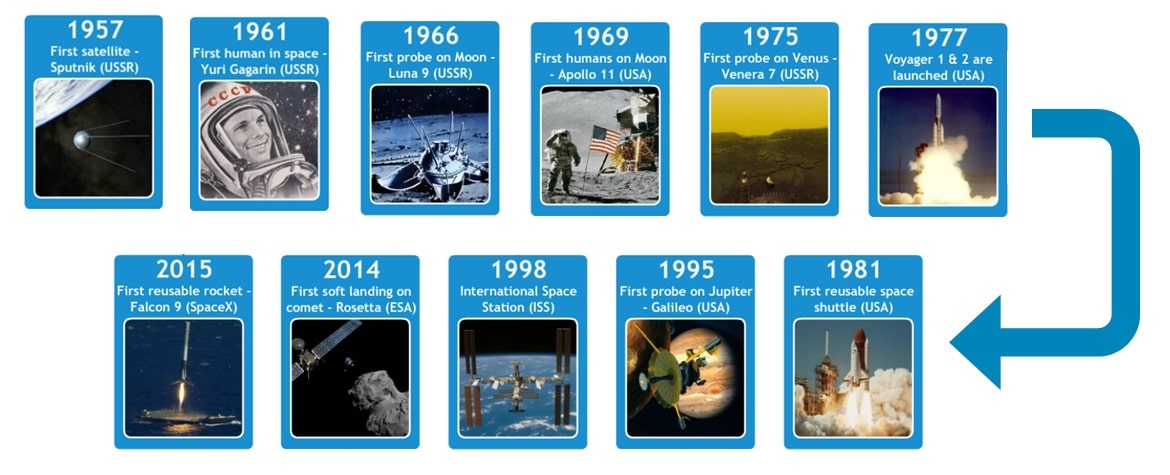Contents
- Solar system originted from a nebula which started collapsing and core formation about 5 to 5.6 billion years ago.
- All planets were formed about 4.6 billion years ago.
- Our solar system consists of the sun (the star), 8 planets, many moons, millions of smaller bodies like asteroids and comets and huge quantity of dust-grains and gases.
- Out of the eight planets, mercury, venus, earth and mars are called as the inner planets as they lie between the sun and the belt of asteroids .
- They are also called Terrestrial, meaning earth-like as they are made up of rock and metals.
- They have relatively high densities.
- Other four planets are called the outer planets and also called Jovian or Gas Giant planets.
- Jovian means Jupiter-like.
- NASA’s Voyager-1 and Voyager-2 only two spacecrafts so far to leave our solar system.
Sun
- Sun is a G2 star and revolves around the galactic core.
- It completes one revolution in 230 million years which is known as 1 Cosmic Year.
- It comprises about 99.86% of the mass of our Solar System.
- Sun is composed primarily of the chemical elements hydrogen and helium.
- Hydrogen converted into helium and energy has been produced by nuclear fusion.
- Sunlight at the top of Earth’s atmosphere is composed
- 50% infrared light
- 40% visible light
- 10% ultraviolet light
- Apparent rotational period of the Sun at its equator is about 28 days
- Average luminance of the Sun is about 1.88 Giga candela /m2, but as viewed through Earth’s atmosphere, this is lowered to about 1.44 Gcd/m2.
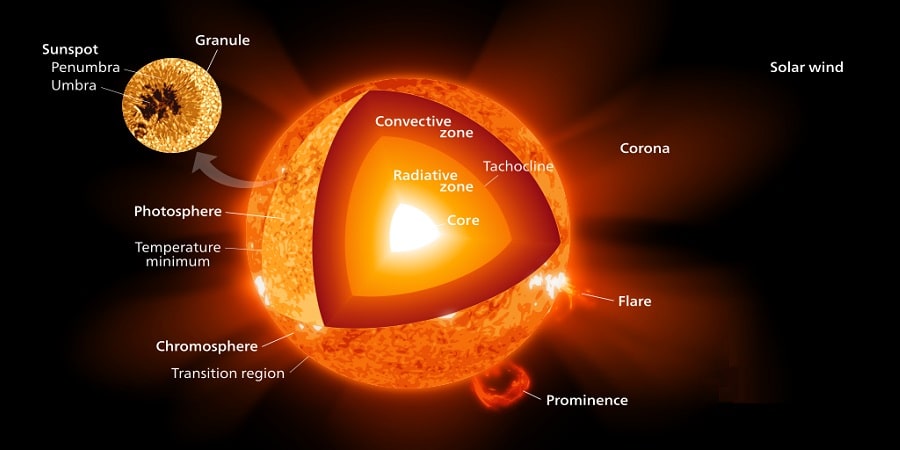
Structure of the Sun
Core
- Innermost 20-25% of the Sun’s radius, where temperature and pressure are sufficient for nuclear fusion
- Hydrogen fuses into helium. The fusion process releases energy
Radiative Zone
- Between about 20-25% of the radius, and 70% of the radius, there is a radiative zone
Tachocline
- the boundary region between the radiative and convective zones.
Convective Zone
- Between about 70% of the Sun’s radius and a point close to the visible surface.
Photosphere
- the deepest part of the Sun which we can directly observe with visible light.
- Photosphere has a temperature of around 6000°C
- Sunspots appears in photosphere
Atmosphere
- A gaseous ‘halo’ surrounding the Sun, comprising
- Chromosphere – Plages occurs here, it is rosy red color, apparent during eclipses
- Solar transition region
- Corona – Outermost part of sun, Solar Flares occurs here
- Heliosphere – is the bubble-like region of space dominated by the Sun, which extends far beyond the orbit of Pluto.
Sunspots
- Sunspots are darker, cooler regions on the bright, hot photosphere.
- Whilst the photosphere has a temperature of around 6000°C, sunspots are between 3000°C and 4000°C.
- They move across the surface of the Sun.
- Sunspots number varies according to the 11-year solar cycle.
- Galileo studied sunspots in 1610.
Solar Flares
- Those are sudden variations in the brightness of a surface region of the Sun.
- Magnetic energy builds up in the solar atmosphere, above active regions
- Solar flares also pose a radiation hazard to astronauts in the International Space Station.
Solar Wind
- Solar wind is a stream of energized, charged particles, primarily electrons and protons.
- It flows outward from the Sun, through the solar system.
- Speed of solar winds as high as 900 km/s and at a temperature of 1 million 0C.
- It is made of plasma.
- Solar winds affect the magnetic field of the Earth.
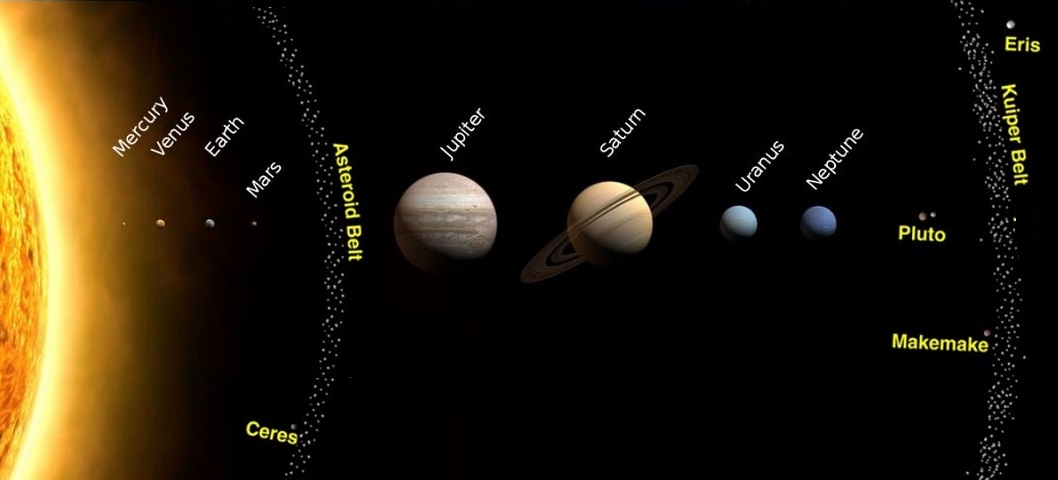
Difference between Terrestrial & Jovian planets
- The terrestrial planets were formed in the close vicinity of the parent star where it was too warm for gases to condense to solid particles.
- Jovian planets were formed at quite a distant location.
- The solar wind was most intense nearer the sun; so, it blew off lots of gas and dust from the terrestrial planets.
- The solar winds were not all that intense to cause similar removal of gases from the Jovian planets.
- The terrestrial planets are smaller and their lower gravity could not hold the escaping gases
Planets of our Solar System
Mercury
- Mercury is the closest planet to the Sun.
- It is also the smallest planet in our Solar System.
- Mercury is made mainly of iron.
- After Earth it is the second most dense planet in our Solar System.
- It has no moon of its own.
- Big differences in day-time ( 427 °C) and night-time ( -173 °C) temperatures
- Orbital period of Mercury is 88 days.
Venus
- Venus is the 2nd planet from the Sun.
- Orbital period of Venus is 224.7 days.
- It has the longest rotation period 243 days
- Venus rotates in the opposite direction to most other planets.
- The Sun would rise in the west and set in the east.
- It does not have any natural satellites
- Venus is the 2nd–brightest natural object in the night sky after the Moon.
- It has the densest atmosphere of the four terrestrial planets, consisting of more than 96% CO2.
- Venus is the hottest planet in our Solar System, with a mean surface temperature of 462 °C.
- It was the 1st planet to have its motions plotted across the sky as early as the 2nd millennium BC.
- Venus is the closest planet to Earth.
- It is similar to Earth in size and mass, and is often described as Earth’s “sister” or “twin”
- Venus was the first planet visited by a spacecraft (Mariner 2 in 1962, by NASA).
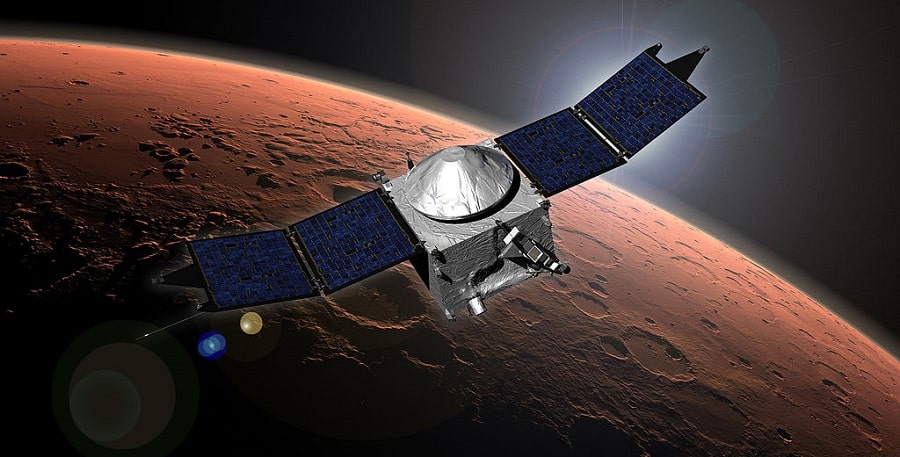
Mars
- Mars is the 4th from Sun and the 2nd smallest planet.
- Olympus Mons is the largest volcano, the tallest planetary mountain with height of 25km.
- Mars has two moons, Phobos and Deimos, may be captured asteroids.
- Mars trojans are a group of objects that share the orbit of the planet Mars around the Sun
- It having about 15% of Earth’s volume and 11% of Earth’s mass, resulting in about 38% of Earth’s surface gravity.
- Mars lost its magnetosphere 4 billion years ago.
- Atmosphere of Mars consists of about 96% CO2.
- Mars has polar ice caps.
- Mariner 9 was 1st successfully mission, 1971, landed a spacecraft on Mars.
- Mangalyaan, is a space probe orbiting Mars, was launched on 5 November 2013 by ISRO
Jupiter
- Jupiter is the 5th from Sun the largest planet.
- Its volume is that of about 1,321 Earths.
- Jupiter and Saturn are gas giants; the other two giant planets, Uranus and Neptune, are ice giants.
- It has 79 known moons.
- Jupiter’s four largest moons Io, Europa, Ganymede and Callisto.
- Those were first observed by Galileo Galilei in 1610 using telescope.
- Io is the most volcanically active body in our solar system.
- Ganymede is the largest moon in the solar system.
- Jupiter has the same ingredients as a star, but it did not grow massive enough to ignite.
- It is composed of hydrogen and helium.
- Jupiter still radiates more heat than it receives from the Sun.
- It has the largest planetary atmosphere in our Solar System, spanning over 5,000 km in altitude.
- Jupiter has the shortest day in our solar system, only about 10 hours.
- It makes a complete orbit around the Sun in about 12 Earth years.
- Its magnetic field is 16 to 54 times as powerful as that of the Earth, causes some of the solar system’s most spectacular aurorae at the planet’s poles.
- 1st spacecraft to visit Jupiter was Pioneer-10 in 1973.
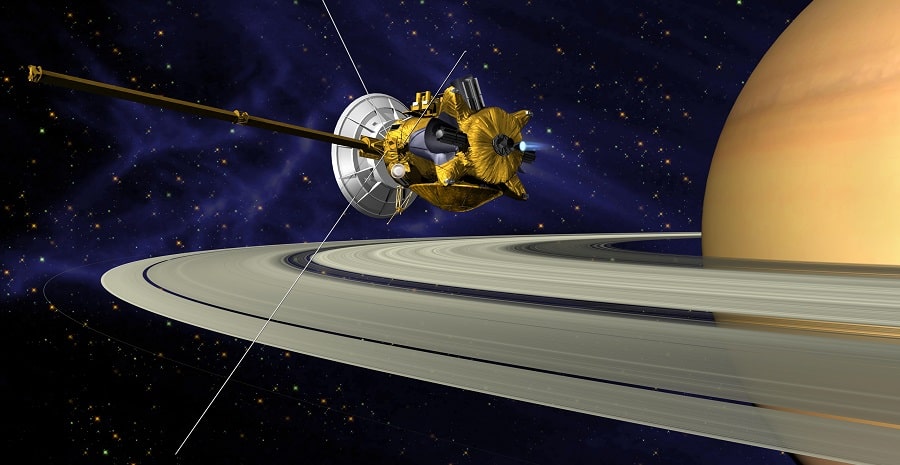
Saturn
- Saturn is the 6th fromthe Sun and 2nd largest planet.
- It has rings, that was first observed in 1610 by the astronomer Galileo Galilei
- Saturn is made mostly of hydrogen and helium.
- One day on Saturn takes only 10.7 hours.
- Saturn makes a complete orbit around the Sun in about 29.4 Earth years.
- Its axis is tilted by 26.73 degrees.
- It is the only planet in our solar system whose average density is less than water.
- Saturn’s rings are thought to be pieces of comets, asteroids or shattered moons that broke up before they reached the planet
- It has 82 moons, in which 53 moons are confirmed and named.
- Largest moon of Saturn is Titan.
- Pioneer 11 launched in 1973 was the 1st mission to Saturn by NASA.
- Cassini mission, was the most important launched in 2004 by NASA.
Uranus
- Uranus is the 7th from Sun and 3rd largest.
- It is very cold and windy planet
- The ice giant is surrounded by 13 faint rings and 27 small moons as it rotates at a nearly 90-degree angle from the plane of its orbit.
- This unique tilt makes Uranus appear to spin on its side, orbiting the Sun like a rolling ball.
- Uranus is the first planet found with the aid of a telescope.
- It was discovered in 1781 by astronomer William Herschel.
- Uranus is 4 times wider than Earth.
- One day on Uranus takes about 17 hours.
- It makes a complete orbit around the Sun in 84 Earth years
- It is the only planet equator is nearly at a right angle to its orbit, with a tilt of 97.77 degrees
- Uranus also rotate in opposite direction like Venus, from east to west
- It has 27 known moons, being named for characters from the works of William Shakespeare and Alexander Pope
- Uranus has two sets of rings.
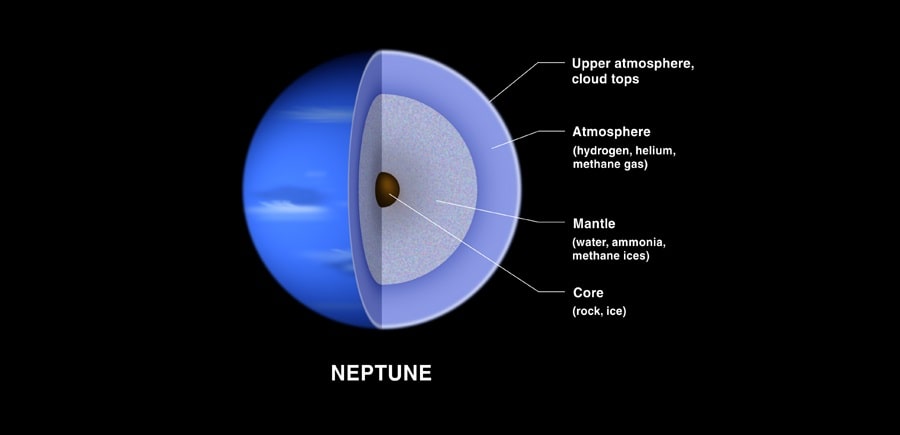
Neptune
- Neptune is the 8th and most distant planet in our solar system.
- It is 30 astronomical units away from the Sun
- Neptune is the only planet in our solar system not visible to the naked eye
- Johann Galle discovered the planet in 1846.
- It is about four times wider than Earth
- One day on Neptune takes about 16 hours
- It makes a complete orbit around the Sun in 165 Earth years
- Of the giant planets, Neptune is the densest
- Its atmosphere is made up mostly of hydrogen and helium with just a little bit of methane
- Neptune is a vivid, brighter blue colored planet.
- It has 13 known moons, largest is Triton.
Dwarf Planets
- It is a planetary-mass object that is neither a true planet nor a natural satellite
- That is, it is in direct orbit of a star, and is massive enough for its gravity to compress it into a hydrostatically equilibriums shape.
- The term dwarf planet was adopted in 2006.
- As of July 2008 the International Astronomical Union (IAU) recognizes five dwarf planets
- Ceres – 1801
- Pluto – 1930
- Haumea – 2004
- Makemake – 2005
- Eris – 2005
Asteroid Belt
- Asteroid Belt is a circumstellar disc in the Solar System.
- It is located between Mars and Jupiter.
- Asteroid Belt is occupied by numerous irregularly shaped bodies called asteroids or minor planets.
- Four largest asteroids
- Ceres
- Vesta
- Pallas
- Hygiea
- Ceres, the asteroid belt’s only dwarf plane.
Kuiper Belt
- Kuiper Belt Objects (KBOs) first time came to light in 1992.
- It is approximately 50 AU from the Sun.
- Kuiper Belt is 20 times as wide and 20 to 200 times as massive then asteroid belt.
- It is the home to 3 recognized dwarf planets
- Pluto
- Haumea
- Makemake
Oort Cloud
- Oort Cloud is believed to be a thick bubble of icy debris that surrounds our solar system
- It exists between 5,000 and 100,000 astronomical units from sun.
- Oort Cloud is too far to be seen with current telescopes, so it hasn’t been directly seen or discovered
- Scientists’ best guess about where long-period comets come from this region.
Meteorites
- Little chunks of rock and debris in space are called meteoroids.
- Meteorite size can about be 1 to 5 meter.
- They become meteors or shooting stars, when they fall through a planet’s atmosphere.
- It leaves a bright trail as they are heated to incandescence by the friction of the atmosphere.
- Several times a year, Earth passes through a trail of debris creating meteor showers.
- Any of these debris that survive the journey and hit the ground are called meteorites.
Comets
- Comets are icy small Solar System body.
- When passing close to the Sun, warms and begins to release gases, a process called outgassing.
- This produces a visible atmosphere or coma, and sometimes also a tail.
- Coma may be up to 15 times the Earth’s diameter, while the tail may stretch one astronomical unit.
- Comets usually have highly eccentric elliptical orbits.
- They have a wide range of orbital periods, ranging from several years to several millions of years.
- Short-period comets originate in the Kuiper belt.
- Long-period comets are thought to originate in the Oort cloud.

